Chairside Pickup of Hader Attachment Sleeves using Condensation Silicone Putty and Pattern Resin- A Novel and Precise Technique
BC Muddugangadhar1, Arindam Das2, Dipal P Mawani3, Arindam Mukhopadhyay4
1 Professor and Ph.D Guide, Department of Prosthodontics, M R Ambedkar Dental College and Hospital, Bengaluru, Karnataka, India.
2 Postgraduate Student, Department of Prosthodontics, M R Ambedkar Dental College and Hospital, Bengaluru, Karnataka, India.
3 Postgraduate Student, Department of Prosthodontics, M R Ambedkar Dental College and Hospital, Bengaluru, Karnataka, India.
4 Postgraduate Student, Department of Prosthodontics, M R Ambedkar Dental College and Hospital, Bengaluru, Karnataka, India.
NAME, ADDRESS, E-MAIL ID OF THE CORRESPONDING AUTHOR: Dr. B C Muddugangadhar, Professor, Department of Prosthodontics and Crown and Bridge including Implantology, M R Ambedkar Dental College and Hospital, Bengaluru, Karnataka, India.
E-mail: drbcmudduphd@gmail.com
This article describes an easy, economic and precise method for chairside pickup of Hader bar sleeves using condensation silicone putty and pattern resin. After torquing the titanium bar, proper block out is carried out using condensation silicone putty, followed by precisely creating space in the intaglio of the denture surface for picking up of the sleeves. Finally, pattern resin is used to pick up the attachment sleeves onto the intaglio surface of the denture.
Introduction
Completely edentulous cases are challenging to rehabilitate when the increased rate of residual ridge resorption leads to compromised retention [1]. To overcome this, placement of two or more implants in the interforaminal region with bar or stud attachment is one of the most commonly preferred options to support an overdenture [2,3]. Hader bar and clip attachments (Hader EDS attachment, Sterngold Dental, LLC, USA) is a common semi-precision bar attachment used nowadays for implant supported overdenture therapy [4]. This bar type of attachment has definite advantages over the stud and magnetic attachments as it provides primary splinting between implants thus facilitating load sharing, better retention and increased attachment service time [5,6]. Prefabricated plastic patterns are supplied by the manufacturer which can be adapted on the master cast, depending upon the amount of vertical space available and then cast with any of the suitable alloys (like titanium or cobalt-chromium) to fabricate the bar [7]. Unlike the other systems where the attachment sleeves are made of metal, Hader Bar system provides plastic sleeves/clips which can be easily picked-up and replaced chairside [7]. Increased chewing efficiency, decreased forward sliding of the dentures and its non-traumatic design help in increasing patient compliance and satisfaction [8,9]. The only drawback of this attachment is that it cannot be used in cases where sufficient vertical and buccolingual space is unavailable [7].
Other than auto polymerizing acrylic resin, various other materials like bis-acryl composite are available in the market for chairside pickup of Hader attachment clips [10,11]. But these materials are costly and technique sensitive for general practitioners.
This article presents an alternative technique for chairside pickup of Hader bar sleeves using condensation silicone putty and pattern resin. This method can also be used to replace worn out or lost Hader clips to increase the service period of the overdenture prosthesis.
Technique
Adequately torque the casted titanium bar on the implants [Table/Fig-1].
Adequately torqued casted titanium bar placed on implants.
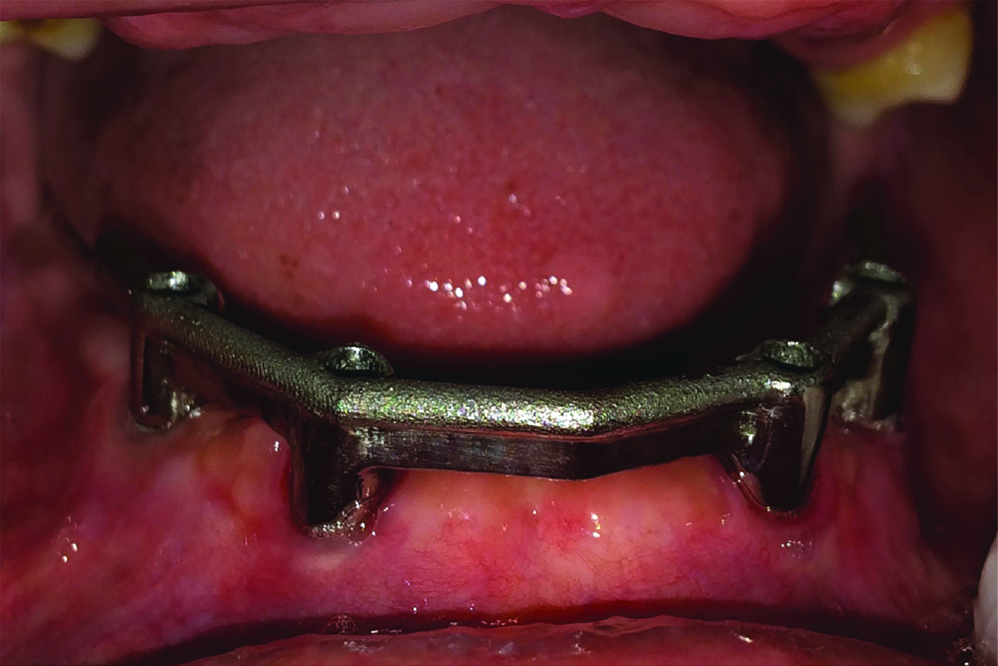
Using the insertion tool, snap in the Hader clips inside the metal housings and place them on the bar [Table/Fig-2].
Hader clips inside the metal housings.
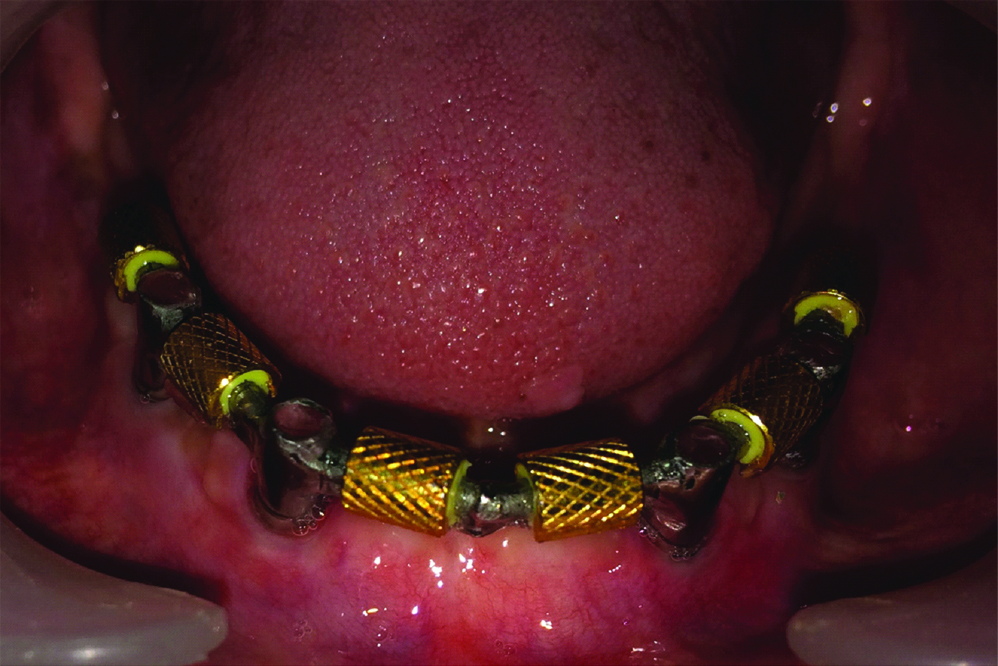
For block out: Manipulate condensation silicone elastomeric impression material (Zhermack Zetaplus Putty, Italy) of putty consistency and block out the undercut area between the bar and the tissue [Table/Fig-3].
Condensation silicone elastomeric impression material (Putty) applied between the bar and the tissue to block out the undercut area. Petrolatum was applied on the exposed surfaces of the bar.
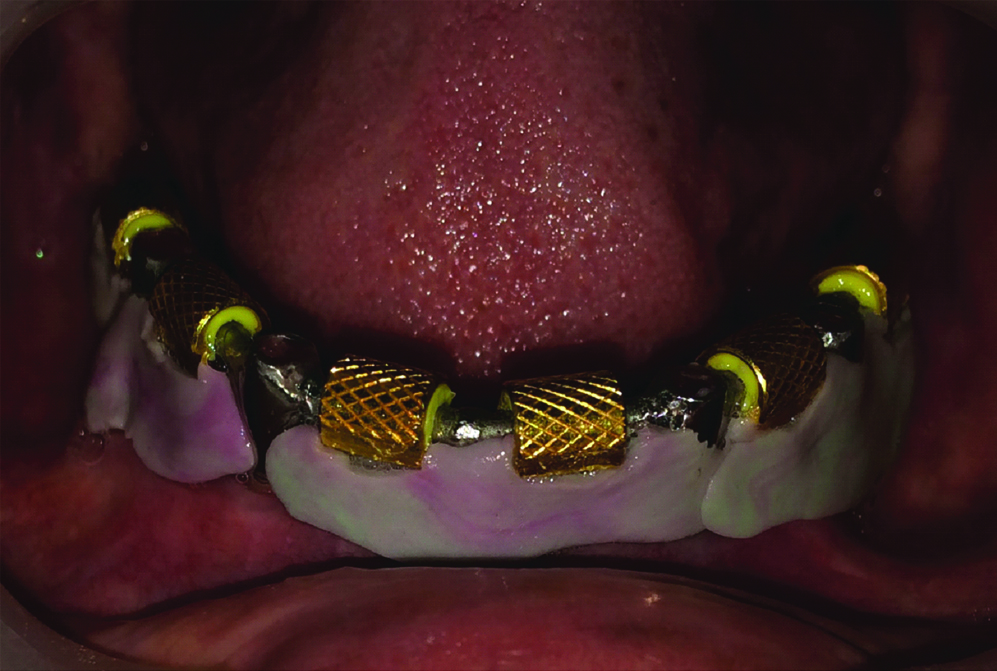
Apply petrolatum on the exposed surfaces of the bar except on the surfaces of the metal housings [Table/Fig-3].
Place peanut size of manipulated putty (same as used in block out procedure) on the metal housings and place the lower denture over the bar with finger pressure.
Mark the area with an indelible ink marker where the putty is picked up on the intaglio surface of the denture [Table/Fig-4]. Reduce the marked area with a small round tungsten carbide bur to provide adequate space for the metal housing.
Putty picked up on the intaglio surface of the denture and the area around is marked with indelible ink for trimming.
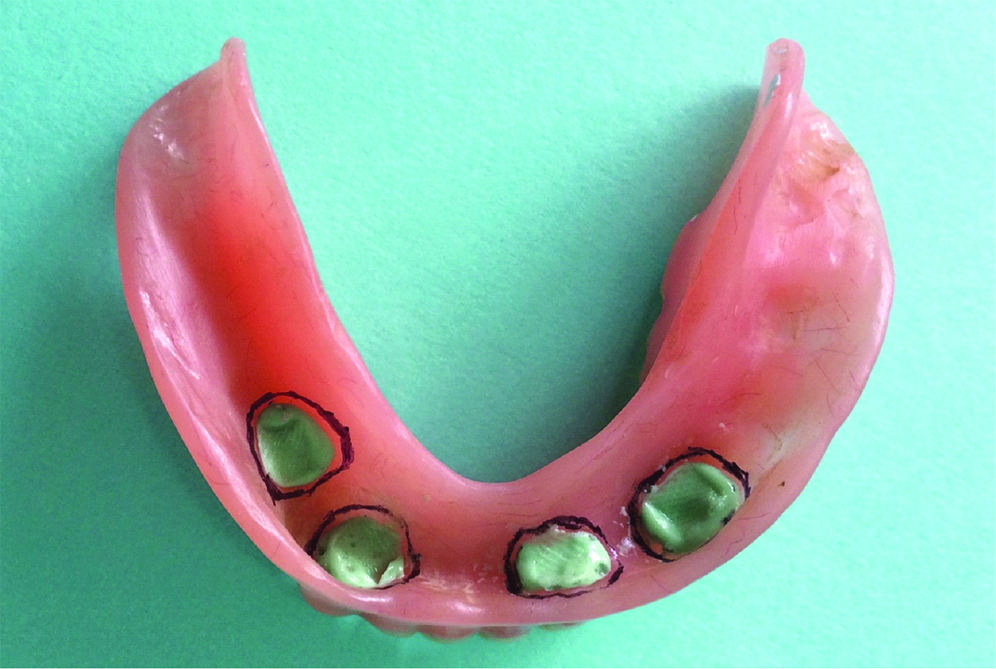
For pickup of metal housing: Manipulate small amount of pattern resin (GC Pattern Resin LS, Tokyo) with a brush and apply it on the metal housings. Seat the denture on the bar and apply gentle finger pressure for 3 to 4 minutes.
After the pattern resin sets, remove the denture from the patient’s mouth and trim the excess set resin from around the metal housing with a round tungsten carbide bur [Table/Fig-5].
Picked-up metal sleeves in finished prosthesis.
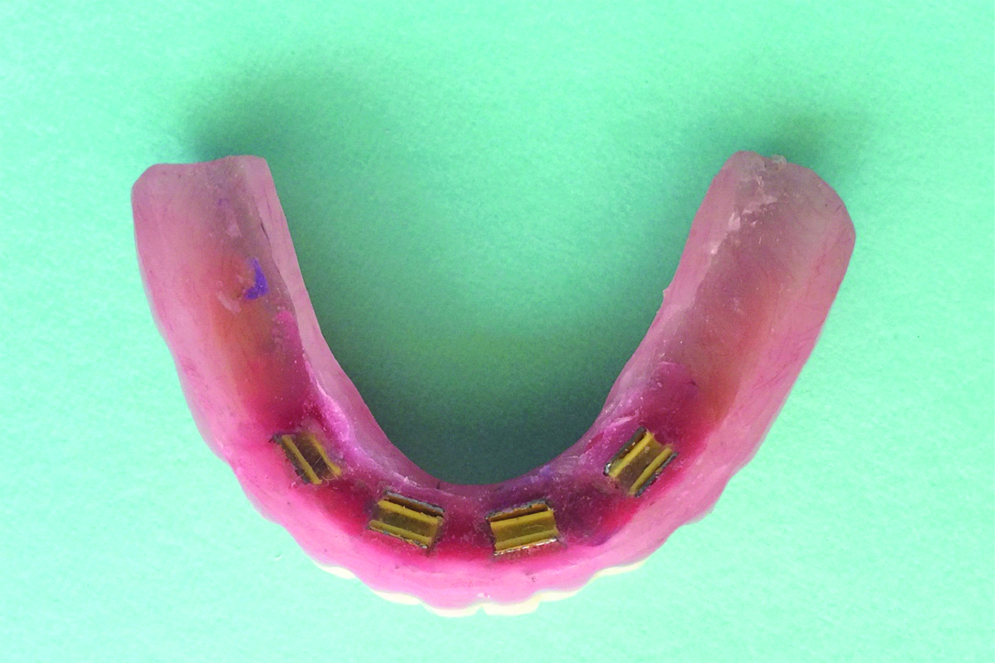
Carefully fill the irregularities between the metal housing and the intaglio surface with autopolymerizing acrylic resin (DPI RR Cold Cure, India) and finish and polish the intaglio surface around the metal housings to make it self-cleansable.
Advantages
The main advantage of this technique is that the use of materials (like condensation silicone putty and pattern resin) that are commonly available in every dental clinic/lab makes the procedure cheaper and simpler for both, general practitioners and prosthodontists.
Limitation
The only limitation of this technique is that if the soft tissue and the titanium bar are not blocked out precisely, then the pattern resin may flow in the undercut areas and on the surface of the titanium bar. The acrylic material of the denture will chemically react with the pattern resin and make the retrieval of the denture difficult.
Conclusion
The method described for pick-up of Hader attachment sleeves in this article requires materials like condensation silicone putty and pattern resin, which are readily available in a dental office. Thus, a clinician who is rehabilitating the dentition using an overdenture supported by a Hader bar can almost always use this easy technique for pickup and replacement of the attachment sleeves.
[1]. Jacobson TE, Krol AJ, A contemporary review of the factors involved in complete denture retention, stability, and support. Part I: retention J Prosthet Dent 1983 49(1):5-15.10.1016/0022-3913(83)90228-7 [Google Scholar] [CrossRef]
[2]. Trakas T, Michalakis K, Kang K, Hirayama H, Attachment systems for implant retained overdentures: a literature review Implant Dent 2006 15(1):24-34.10.1097/01.id.0000202419.21665.3616569958 [Google Scholar] [CrossRef] [PubMed]
[3]. Meijer HJ, Starmans FJ, Steen WH, Bosman F, Location of implants in the interforaminal region of the mandible and the consequences for the design of the superstructure J Oral Rehabil 1994 21(1):47-56.10.1111/j.1365-2842.1994.tb01123.x8133388 [Google Scholar] [CrossRef] [PubMed]
[4]. Shafie H, Principles of attachment selection Clinical and Laboratory Manual of Implant Overdentures 2007 Ames, IowaBlackwell:69 [Google Scholar]
[5]. Martínez-Lage-Azorín JF, Segura-Andres G, Faus-Lopez J, Agustín-Panadero R, Rehabilitation with implant-supported overdentures in total edentulous patients: a review J Clin Exp Dent 2013 5(5):e267-72.10.4317/jced.5081724455093 [Google Scholar] [CrossRef] [PubMed]
[6]. Van Kampen F, Cune M, Van Der Bilt A, Bosman F, Retention and postinsertion maintenance of bar-clip, ball and magnet attachments in mandibular implant overdenture treatment: an in vivo comparison after 3 months of function Clin Oral Implants Res 2003 14(6):720-26.10.1046/j.0905-7161.2003.00961.x15015948 [Google Scholar] [CrossRef] [PubMed]
[7]. Singh K, Gupta N, Kapoor V, Gupta R, Case Report: Hader bar and clip attachment retained mandibular complete denture BMJ Case Rep 2013 2013:pii: bcr201301040110.1136/bcr-2013-01040124145505 [Google Scholar] [CrossRef] [PubMed]
[8]. Botega DM, Mesquita MF, Henriques GE, Vaz LG, Retention force and fatigue strength of overdenture attachment systems J Oral Rehabil 2004 31(9):884-89.10.1111/j.1365-2842.2004.01308.x15369470 [Google Scholar] [CrossRef] [PubMed]
[9]. Daher T, A simple, predictable intraoral technique for retentive mechanism attachment of implant overdenture attachments J Prosthodont 2003 12(3):202-05.10.1016/S1059-941X(03)00049-4 [Google Scholar] [CrossRef]
[10]. Sadig WM, Special technique for attachment incorporation with an implant overdenture J Prosthet Dent 2003 89(1):93-96.10.1067/mpr.2003.612589297 [Google Scholar] [CrossRef] [PubMed]
[11]. Scherer MD, Case Report: Implant Attachment Pick-up Technique for Converting a Denture into an Overdenture https://www.michaelschererdmd.com/wp-content/uploads/2015/09/SchererMD_DPS_2014-2.pdf [Google Scholar]